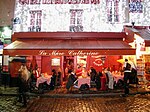Montmartre Funicular

The Montmartre Funicular (French: Funiculaire de Montmartre) is an inclined transport system serving the Montmartre neighbourhood of Paris, France, in the 18th arrondissement. Operated by the RATP, the Paris transport authority, the system opened in 1900; it was entirely rebuilt in 1935 and again in 1991. The system is a funicular in name only. Its formal title, the Montmartre Funicular, is a vestige of its earlier configuration, where its cars operated in a counterbalanced, interconnected pair, always moving in opposite directions in concert, thus meeting the definition of a funicular. The system now uses two independently operating cars that can each ascend or descend on demand, qualifying as a double inclined elevator, retaining the term funicular in its title as a historical reference. The system carries passengers between the base of Montmartre and its summit, accessing the nearby Sacré-Cœur basilica and paralleling the adjacent staircases of Rue Foyatier. The 108 m (354 ft) cars climbs 36 m (118 ft) in under a minute and a half and carry two million passengers a year.
Excerpt from the Wikipedia article Montmartre Funicular (License: CC BY-SA 3.0, Authors, Images).Montmartre Funicular
Rue Foyatier, Paris Quartier de Clignancourt (Paris)
Geographical coordinates (GPS) Address Nearby Places Show on map
Geographical coordinates (GPS)
| Latitude | Longitude |
|---|---|
| N 48.885277777778 ° | E 2.3425 ° |
Address
Rue Foyatier
Rue Foyatier
75018 Paris, Quartier de Clignancourt (Paris)
Ile-de-France, France
Open on Google Maps











